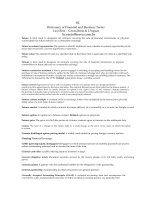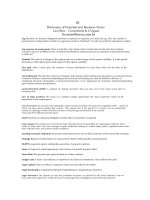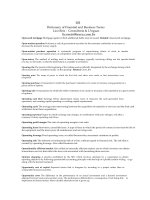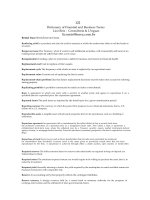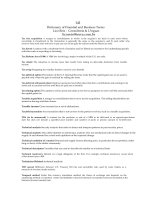canadian dictionary of finance and investment terms
Bạn đang xem bản rút gọn của tài liệu. Xem và tải ngay bản đầy đủ của tài liệu tại đây (3.39 MB, 1,189 trang )
Page i
Canadian Dictionary of Finance and Investment Terms
Jerry White
M.A., Econ., M.B.A., D.Litt.
Chairman, J. White & Associates Inc. & Nework Corp.
John Downes
Editor, Beating the Dow
Former Vice President, AVCO Financial Services, Inc.
Office for Economic Development, City of New York
Jordan Elliot Goodman
Financial Analyst, NBC News at Sunrise
Author, Everyone's Money Book
Creator, The Money Answers Program
Former Wall Street Correspondent,
MONEY Magazine, Time Warner Incorporated
Former Business News Commentator,
Mutual Broadcasting System
Second Edition
Page ii
© Copyright 2000 by Barron's Educational Series, Inc.
Prior edition © 1995 by Barron's Educational Series, Inc.
All rights reserved.
No part of this book may be reproduced in any form, by photostat,
microfilm, xerography, or any other means, or incorporated into any
information retrieval system, electronic or mechanical, without the written
permission of the copyright owner.
All inquiries should be addressed to:
Barron's Educational Series, Inc.
250 Wireless Boulevard
Hauppauge, NY 11788
Library of Congress Catalog Card No. 00-036294
International Standard Book No. 0-7641-1261-9
Library of Congress Cataloging-in-Publication Data
White, Jerry, 1946–
Canadian dictionary of finance and investment terms /
Jerry White, John Downes, Jordan Elliot Goodman.—2nd
ed.
p. cm.
Includes bibliographical references and index.
ISBN 0-7641-1261-9 (pbk.)
1. Finance — Dictionaries. 2. Finance — Canada —
Dictionaries. I. Downes, John, 1936–. II. Goodman, Jordan
Elliot. III. Title.
HG151.W47 2000
332´.03—dc21
00-
036294
PRINTED IN THE UNITED STATES OF AMERICA
9 8 7 6 5 4 3 2 1
Page iii
CONTENTS
Preface iv
How to Use This Book Effectively vi
Terms 1
Abbreviations and Acronyms 594
Page iv
PREFACE
In this new millennium, the quest is for knowledge as well as information. A
recent survey of consumers/investors shows that male investors seek
information on how to make better informed decisions, while female
investors wanted education on how to make better decisions.
The E-commerce and Internet revolution has democratized capitalism,
allowing the consumer equal access to corporate information as well as
investment options and services. Today, any consumer with investable
dollars can access the services that in the sixties and seventies were
available only to the very rich.
With the explosion of on-line information, there is an ever increasing level
of sales in books. Perhaps, the model of high-tech-high-touch was correct.
As the population ages, the demand for the bound book has made a great
recovery. This volume is a prime example of the value of the printed word
as a reference and educational source accessible to all.
A reader wrote to us to compliment us on the first Canadian edition. He
said that while he was in his late fifties, he was new as an investor and until
four years ago, he found himself lost while reading newspapers,
newsletters, books, and watching financial programs on television. He was
unable to follow them as he did not have the background in the field and he
”could not grasp the terminology or concepts.” His financial adviser gave
him a copy of this text. He now keeps it on his nightstand for quick access,
while he does his financial research. The reader said that the book
“empowered” him to be a more knowledgeable and better-educated
consumer of financial products and now he recommends it to all of his
friends and even his children.
This is the key role of this book: to be a companion to you in your research
and reading, and to add clarity, to simplify, and, to ultimately improve your
knowledge.
We also recognize that the financial world is quite dynamic, and that the
terminology and concepts must be constantly updated to reflect the ‘‘here
and now.” Otherwise, this text would be of no strategic value.
In this second Canadian edition, we have tried to ensure that we have
covered tax terminology more extensively to reflect its ever increasing
incursion into our lives and its actual importance in all financial decision
making.
Mutual fund terms and related concepts have also been greatly expanded
and we have reviewed all regulatory sources to make sure that the most
current legislation and regulatory matters have been included.
We, of course, have deleted terms that lack contemporary relevance or
are in such select usage, as to be of little value today.
The text should benefit students, stockbrokers, financial planners, their
clients, writers, consumer readers and researchers.
Extensive research was conducted by Ian White, Hartley White, and
Mariam White in preparation of this update.
Will this new era of affluence and the inclusion economy continue? We
have no idea. But the better informed and educated reader will certainly
have
Page v
an advantage over most, ensuring some participation in whatever success
arises in the years ahead. That is the principal objective of this dictionary.
The authors were helped by many organizations and people, among them:
The American Association of Individual Investors, American Bankers
Association, American Council of Life Insurance, American Express
Company, American Institute of Certified Public Accountants, American
Society of CLU & CHFC (Chartered Life Underwriters), American Stock
Exchange, Associated Credit Bureaus, Bankers Trust Company, The Bond
Buyer, Boston Stock Exchange, Chase Manhattan Bank NA, Chicago
Board Options Exchange, Coffee, Sugar & Cocoa Exchange, Commodity
Futures Trading Commission, DD&W Limited, Dow Jones, Employee
Benefit Research Institute, Fannie Mae, Federal Energy Regulatory
Commission, Federal Reserve Bank of New York, Federal Trade
Commission, FINEX, Frank Russell Company, Futures Industry
Association, Goldman, Sachs & Company, Health Insurance Institute of
America, Hulbert Financial Digest, IBC/Donoghue Incorporated, I/B/E/S
Incorporated, Insurance Information Institute, Intermarket Management
Incorporated, Internal Revenue Service, International Petroleum Exchange,
International Swaps and Derivatives Association, Investment Management
Consultants Association, Investment Program Association, J.P Morgan,
Richard J. Kittrell, Esq./Kittrell & Kittrell P.C., Liquidity Financial
Corporation, Mercer and Company, Merrill Lynch, Montreal Exchange,
Morgan Stanley, Morningstar, Mortgage Bankers Association, Municipal
Bond Investors Assurance Corporation, National Association of Investors
Corporation, National Association of Real Estate Investment Trusts,
National Association of Variable Annuities, National Credit Union
Administration, New York Cotton Exchange, New York Life Insurance
Company, New York Mercantile Exchange, New York Stock Exchange,
Office of Thrift Supervision, Options Clearing Corporation, Options
Institute, Pension Benefit Guaranty Corporation, Prudential Securities,
Salomon Brothers Incorporated, Securities and Exchange Commission,
Standard & Poor's, Toronto Stock Exchange, Trimedia Incorporated, U.S.
Department of Commerce, U.S. Department of Labor, Value Line,
Vancouver Stock Exchange, Visa International, The Weiser Walek Group,
Wheat First Butcher Singer Incorporated, Wilshire Associates, Winnipeg
Commodity Exchange, World Gold Council, Wrap Industry Association,
and Zacks Investment Research.
Expert reviewing was provided by Paul Bates of Charles Schwab Canada,
Mark Borkowski of Mercantile Mergers and Acquisitions, Robert Walker,
president of J. White & Associates, Inc. We also received material
assistance from brokers, financial planners, and professional advisors too
numerous to mention.
Special thanks are due to Roberta Yafie, whose fact-checking and
research went far beyond the call of duty and to Brian Cox of Barron's, who
worked with us in championing the project.
Jerry White
John Downes
Jordan Elliot Goodman
Page vi
HOW TO USE THIS BOOK EFFECTIVELY
Alphabetization: All entries are alphabetized by letter rather than by word
so that multiple-word terms are treated as single words. For example, NET
ASSET VALUE follows NET ASSETS as though it were spelled
NETASSETVALUE, without spacing. Similarly, ACCOUNT EXECUTIVE
follows ACCOUNTANT'S OPINION. In unusual cases, abbreviations or
acronyms appear as entries in the main text, in addition to appearing in the
back of the book in the separate listing of Abbreviations and Acronyms.
This is when the short form, rather than the formal name, predominates in
common business usage. For example, NASDAQ is more commonly used
in speaking of the National Association of Securities Dealers Automated
Quotations system than the name itself, so the entry is at NASDAQ.
Numbers in entry titles are alphabetized as if they were spelled out.
Abbreviations and Acronyms: A separate list of abbreviations and
acronyms follows the Dictionary. It contains shortened versions of terms
defined in the book, plus several hundred related business terms.
Cross references: In order to gain a fuller understanding of a term, it will
sometimes help to refer to the definition of another term. In these cases
the additional term is printed in SMALL CAPITALS. Such cross references
appear in the body of the definition or at the end of the entry (or subentry).
Cross references at the end of an entry (or subentry) may refer to related
or contrasting concepts rather than give more information about the
concept under discussion. As a rule, a term is printed in small capitals only
the first time it appears in an entry. Where an entry is fully defined at
another entry, a reference rather than a definition is provided; for example,
EITHER-OR ORDER see ALTERNATIVE ORDER.
Italics: Italic type is generally used to indicate that another term has a
meaning identical or very closely related to that of the entry. Occasionally,
italic type is also used to highlight the fact that a word used is a business
term and not just a descriptive phrase. Italics are also used for the titles of
publications.
Parentheses: Parentheses are used in entry titles for two reasons. The
first is to indicate that an entry's opposite is such an integral part of the
concept that only one discussion is necessary; for example, REALIZED
PROFIT (OR LOSS). The second and more common reason is to indicate
that an abbreviation is used with about the same frequency as the term
itself; for example, OVER THE COUNTER (OTC).
Examples, Illustrations, and Tables: The numerous examples in this
Dictionary are designed to help readers gain understanding and to help
them relate abstract concepts to the real world of finance and investment.
Line drawings are provided in addition to text to clarify concepts best
understood visually; for example, technical chart patterns used by
securities analysts and graphic concepts used in financial analysis.
Page 1
A
ABANDONMENT voluntarily giving up all rights, title, or claims to property
that rightfully belongs to the owner. An example of abandoned property
would be stocks, bonds, or mutual funds held in a brokerage account for
which the firm is unable to locate the listed owner over a specified period of
time, usually a few years. If ruled to be abandoned, the property may revert
to the state under the laws of ESCHEAT. In addition to financial assets,
other kinds of property that are subject to abandonment include patents,
inventions, leases, trademarks, contracts, and copyrights.
ABC INVENTORY CONTROL SYSTEM system of dividing a firm's
inventory system into three groups, A, B, and C, according to the
contribution of each to the firm's overall investment in the inventory. The
system facilitates the application of more effective and efficient inventory
control techniques.
ABILITY TO PAY
Finance: borrower's ability to meet principal and interest payments on
long-term obligations out of earnings. Also called ability to service. See
also FIXED CHARGE COVERAGE.
Industrial relations: ability of an employer, especially a financial
organization to meet a union's financial demands from operating income.
Municipal bonds: issuer's present and future ability to generate enough
tax revenue to meet its contractual obligations, taking into account all
factors concerned with municipal income and property values.
Taxation: the concept that tax rates should vary with levels of wealth or
income; for example, the progressive income tax.
ABOVE PAR see PAR VALUE.
ABSORBED
Business: a cost that is treated as an expense rather than passed on to a
customer.
Also, a firm merged into an acquiring company.
Cost accounting: indirect manufacturing costs (such as property taxes
and insurance) are called absorbed costs. They are differentiated from
variable costs (such as direct labour and materials). See also DIRECT
OVERHEAD.
Finance: an account that has been combined with related accounts in
preparing a financial statement and has lost its separate identity. Also
called absorption account or adjunct account.
Securities: issue that an underwriter has completely sold to the public.
Also, in market trading, securities are absorbed as long as there are
corresponding orders to buy and sell. The market has reached the
absorption point when further assimilation is impossible without an
adjustment in price. See also UNDIGESTED SECURITIES.
Page 2
ACCELERATED COLLECTION see LOCK-BOX SERVICE.
ACCELERATED FUNDS TRANSFER a computer-based electronic funds
transfer system for inter- and intra-account transfer, bill payment, accounts
receivable collection, and overall management.
ACCELERATION CLAUSE provision, normally present in an INDENTURE
agreement, mortgage, or other contract, that the unpaid balance is to
become due and payable if specified events of default should occur. Such
events include failure to meet interest, principal, or sinking fund payments;
insolvency; and nonpayment of taxes on mortgaged property.
ACCEPTANCE
In general: agreement created when the drawee of a TIME DRAFT (bill of
exchange) writes the word “accepted” above the signature and designates
a date of payment. The drawee becomes the acceptor, responsible for
payment at maturity.
Also, paper issued and sold by sales finance companies, such as General
Motors Acceptance Corporation.
Banker's acceptance: time draft drawn on and accepted by a bank, the
customary means of effecting payment for merchandise sold in import-
export transactions and a source of financing used extensively in
international trade. With the credit strength of a bank behind it, the banker's
acceptance usually qualifies as a MONEY MARKET instrument. The
liability assumed by the bank is called its acceptance liability. See also
LETTER OF CREDIT.
Trade acceptance: time draft drawn by the seller of goods on the buyer,
who becomes the acceptor, and which is therefore only as good as the
buyer's credit.
ACCEPTANCE PAPER colloquial term for short-term promissory notes
issued by sales finance companies to fund loans to consumers for cars,
appliances, etc. See also FINANCE COMPANY PAPER.
ACCIDENT, DEATH AND DISMEMBERMENT INSURANCE insurance
that provides benefits if the policyholder dies as a result of an accident or if
he or she suffers the loss of a limb.
ACCIDENT INSURANCE mandatory auto insurance that provides
coverage for medical payments over and above those paid by any
provincial health plan.
ACCOUNT
In general: contractual relationship between a buyer and seller under
which payment is made at a later time. The term open account or charge
account is used, depending on whether the relationship is commercial or
personal.
Also, the historical record of transactions under the contract, as
periodically shown on the statement of account.
Banking: relationship under a particular name, usually evidenced by a
Page 3
deposit against which withdrawals can be made. Among them are demand,
time, custodial, joint, trustee, corporate, special, and regular accounts.
Administrative responsibility is handled by an account officer.
Bookkeeping: assets, liabilities, income, and expenses as represented
by individual ledger pages to which debit and credit entries are
chronologically posted to record changes in value. Examples are cash,
accounts receivable, accrued interest, sales, and officers' salaries. The
system of recording, verifying, and reporting such information is called
accounting. Practitioners of accounting are called accountants.
Investment banking: financial and contractual relationship between
parties to an underwriting syndicate, or the status of securities owned and
sold.
Securities: relationship between a broker-dealer firm and its client
wherein the firm, through its registered representatives, acts as agent in
buying and selling securities and sees to related administrative matters.
See also ACCOUNT STATEMENT.
ACCOUNT ANALYSIS informational report provided by a bank to its
corporate customers with data detailing account service activity. Such
reports are produced monthly as well as annually and usually detail: the
average daily book balance, the average daily float, average available
balances, itemized activity charges, earnings credit rate, the balanced
required to compensate for services, and the balance available to support
credit arrangement and other bank services.
ACCOUNTANT'S REVIEW report attached to financial statements that
have been prepared without audit but reviewed by a firm of Chartered
Accountants. The “Review Engagement Report” states that the review
‘‘consisted primarily of enquiry, analytical procedures and discussion” of
the figures and “does not constitute an audit” or result in an audit opinion.
Outsiders usually do not place full confidence in such figures. See also
AUDITED FINANCIAL STATEMENTS.
ACCOUNT BALANCE net of debits and credits at the end of a reporting
period. Term applies to a variety of account relationships, such as with
banks, credit card companies, brokerage firms, and stores, and to
classifications of transactions in a bookkeeping system. The same
account may be an asset account balance or a liability account balance,
depending on which side of the transaction you are on. For example, your
bank balance is an asset account to you and a liability account to the bank.
Your credit card (debit) balance is a liability account to you and an asset
account (account receivable) to the credit card company.
ACCOUNTING PRINCIPLES BOARD (APB) board of the American
Institute of Certified Public Accountants (AICPA) that issued (1959–73) a
series of accountant's opinions constituting much of what is known as
GENERALLY ACCEPTED ACCOUNTING PRINCIPLES. See also
FINANCIAL ACCOUNTING STANDARDS BOARD (FASB); CANADIAN
INSTITUTE OF CHARTERED ACCOUNTANTS (CICA).
Page 4
ACCOUNT RECONCILIATION the process of adjusting the balance in
your chequebook to match your bank statement. Your chequebook
balance, plus outstanding cheques, less bank charges, plus interest (if
any), should equal the balance shown on your bank statement.
ACCOUNTS PAYABLE amounts owing on open account to creditors for
goods and services that are payable within one year or business cycle.
Analysts look at the relationship of accounts payable to purchases for
indications of sound day-to-day financial management. See also TRADE
CREDIT.
ACCOUNTS RECEIVABLE money owed to a business for merchandise or
services sold on open account, payable within one year or business cycle.
Accounts receivable are a key factor in analyzing a company's LIQUIDITY
—its ability to meet current obligations without additional revenues. See
also ACCOUNTS RECEIVABLE TURNOVER; AGING SCHEDULE;
COLLECTION RATIO.
ACCOUNTS RECEIVABLE FINANCING short-term financing whereby
accounts receivable serve as collateral for working capital advances. See
also FACTORING.
ACCOUNTS RECEIVABLE INSURANCE insurance that protects
accounts receivable of a client owing money from physical loss because of
fire, theft or any other named peril.
ACCOUNTS RECEIVABLE TURNOVER ratio obtained by dividing total
credit sales by accounts receivable. The ratio indicates how many times
the receivables portfolio has been collected during the accounting period.
See also ACCOUNTS RECEIVABLE; AGING SCHEDULE;
COLLECTION RATIO.
ACCOUNT STATEMENT
In general: any record of transactions and their effect on charge or open-
account balances during a specified period.
Banking: summary of all cheques paid, deposits recorded, and resulting
balances during a defined period. Also called a bank statement.
Securities: statement summarizing all transactions and showing the status
of an account with a broker-dealer firm, including long and short positions.
Such statements must be issued quarterly, but are generally provided
monthly when accounts are active.
ACCRETION
1. asset growth through internal expansion, acquisition, or such
causes as aging of whisky or growth of timber.
2. adjustment of the difference between the price of a bond bought at
an original discount and the par value of the bond.
ACCRUAL BASIS accounting method whereby income and expense items
are recognized as they are earned or incurred, even though they
Page 5
may not have been received or actually paid in cash. Accrual accounting
provides an accurate picture of a company's performance buy cannot
assist in monitoring cash flow. The alternative is CASH BASIS accounting.
ACCRUED BENEFITS pension benefits that an employee has earned
based on his or her years of service at a company. See also VESTING.
ACCRUED CAPITAL GAIN unrealized gain that has been created by the
increase in value of an investment or other asset; excess of market value
over adjusted cost base. An accrued gain is a gain that exists before the
investment is sold, or deemed sold, to realize the gain.
ACCRUED INTEREST interest that has accumulated between the most
recent payment and the sale of a bond or other fixed-income security. At
the time of sale, the buyer pays the seller the bond's price plus accrued
interest, calculated by multiplying the coupon rate by the number of days
that have elapsed since the last payment.
ACCRUED MARKET DISCOUNT increase in market value of a
DISCOUNT BOND that occurs because of its approaching MATURITY
DATE (when it is redeemable at PAR) and not because of declining market
interest rates.
ACCRUED TAX LIABILITY unrealized tax liability relating to an accrued
CAPITAL GAIN. The tax liability continues to accrue as the accrued capital
gain increases. This liability will become taxes payable when the investment
is eventually sold, or deemed sold, and the gain is realized.
ACCUMULATED DIVIDEND dividend due, usually to holders of cumulative
preferred stock, but not paid. It is carried on the books as a liability until
paid. See also CUMULATIVE PREFERRED.
ACCUMULATION
Corporate finance: profits that are not paid out as dividends but are
instead added to the company's capital base. See also ACCUMULATED
PROFITS TAX.
Investments: purchase of a large number of shares in a controlled way so
as to avoid driving the price up. An institution's accumulation program, for
instance, may take weeks or months to complete.
Mutual funds: investment of a fixed dollar amount regularly and
reinvestment of dividends and capital gains.
ACCUMULATION AREA price range within which buyers accumulate
shares of a stock. Technical analysts spot accumulation areas when a
stock does not drop below a particular price. Technicians who use the ON-
BALANCE VOLUME method of analysis advise buying stocks that
Page 6
have hit their accumulation area, because the stocks can be expected to
attract more buying interest. See also DISTRIBUTION AREA.
ACES acronym for Advanced Computerized Execution System, run by
the NASDAQ stock market. ACES automates trades between order-entry
and market-maker firms that have established trading relationships with
each other, designating securities at specified quantities for automatic
execution. Once trading parameters are set, ACES facilitates order entry,
best-price order execution and limited-order maintenance, as well as a
variety of inventory control capabilities. Trades are then automatically
reported for public dissemination and sent for comparison and clearing.
ACID TEST current cash and “near” cash assets (e.g., government bonds
and current receivables, but excluding inventory) compared to the current
debts (bank loans, payables). The acid test shows how much and how
quickly cash can be found if a company gets into trouble.
ACID-TEST RATIO See QUICK RATIO.
ACKNOWLEDGMENT verification that a signature on a banking or
brokerage document is legitimate and has been certified by an authorized
person. Acknowledgment is needed when transferring an account from one
broker to another, for instance. In banking, an acknowledgment verifies that
an item has been received by the paying bank and is or is not available for
immediate payment.
ACQUIRED SURPLUS uncapitalized portion of the net worth of a
successor company in a POOLING OF INTERESTS combination. In other
words, the part of the combined net worth not classified as CAPITAL
STOCK.
In a more general sense, the surplus acquired when a company is
purchased.
Page 7
ACQUISITION one company taking over controlling interest in another
company. Investors are always looking out for companies that are likely to
be acquired, because those who want to acquire such companies are
often willing to pay more than the market price for the shares they need to
complete the acquisition. See also MERGER; POOLING OF INTERESTS;
TAKEOVER.
ACQUISITION COST
Finance: price plus CLOSING COSTS to buy a company, real estate or
other property.
Investments: SALES CHARGE incurred to buy a LOAD FUND or the
original price, plus brokerage commissions, of a security. See also TAX
BASIS.
ACQUISITION FEE see LOAD.
ACROSS THE BOARD movement in the stock market that affects almost
all stocks in the same direction. When the market moves up across the
board, almost every stock gains in price.
An across-the-board pay increase in a company is a raise of a fixed
percent or amount for all employees.
ACTIVE BOND CROWD members of the bond department of the New
York Stock Exchange, the most important bond traders in North America,
responsible for the heaviest volume of bond trading. The opposite of the
active crowd is the CABINET CROWD, which deals in bonds that are
infrequently traded. Investors who buy and sell bonds in the active crowd
will tend to get better prices for their securities than in the inactive market,
where spreads between bid and asked prices are wider.
ACTIVE BOX collateral available for securing brokers' loans or customers'
margin positions in the place—or box—where securities are held in
safekeeping for clients of a broker-dealer or for the broker-dealer itself.
Securities used as collateral must be owned by the firm or hypothecated—
that is, pledged or assigned—by the customer to the firm, then by the
broker to the lending bank. For margin loans, securities must be
hypothecated by the customer to the broker.
ACTIVE MANAGEMENT management of, for example, MUTUAL FUNDS
by professional money managers who actively buy and sell investments in
an attempt to produce a greater rate of return than the market does. The
opposite of PASSIVE MANAGEMENT.
ACTIVE MARKET heavy volume of trading in a particular stock, bond, or
commodity. The spread between bid and asked prices is usually narrower
in an active market than when trading is quiet.
Also, a heavy volume of trading on the exchange as a whole. Institutional
money managers prefer such a market because their trades of large
blocks of stock tend to have less impact on the movement of prices when
trading is generally active.

